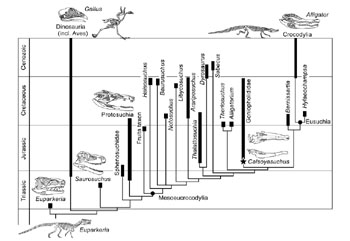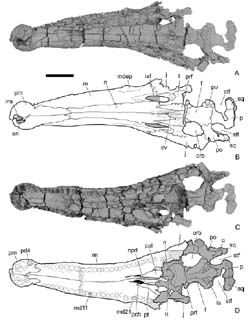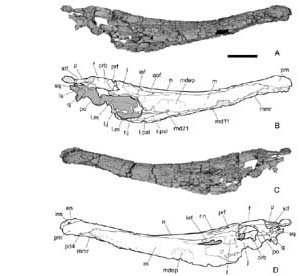Literature
Benton, M. J., and J. M. Clark. 1988. Archosaur phylogeny and the relationships of the Crocodylia; pp. 295338 in M. J. Benton (ed.), The Phylogeny and Classification of the Tetrapods, Vol. 1. Amphibians, Reptiles, Birds. Systematics Association Special Volume
No. 35A. Clarendon Press, Oxford.
Brochu, C. A. 1997a. Morphology, fossils, divergence timing, and the
phylogenetic relationships of Gavialis. Systematic Biology 46:479522.
1997b. A review of "Leidyosuchus" (Crocodyliformes, Eusuchia) from the Cretaceous through Eocene of North America. Journal of Vertebrate Paleontology 17:679697.
1999. Phylogenetics, taxonomy, and historical biogeography of Alligatoroidea; pp. 9100 in T. Rowe, C. A. Brochu, and K. Kishi
(eds.), Cranial Morphology of Alligator and Phylogeny of Alligatoroidae. Society of Vertebrate Paleontology Memoir 6, Journal of Vertebrate Paleontology 19, supplement to number 2.
Buckley, G. A., and C. A. Brochu. 1999. An enigmatic new crocodile from the Upper Cretaceous of Madagascar; pp. 149175 in D. Unwin (ed.), Cretaceous Terrestrial Vertebrates. Special Papers in Palaeontology, No. 60.
, C. A. Brochu, D. W. Krause, and D. Pol. 2000. A pug-nosed crocodyliform from the Late Cretaceous of Madagascar. Nature 405:941944.
Buffetaut, E., and S. Hutt. 1980. Vectisuchus leptognathus, n.g. n. sp., a slender-snouted goniopholid crocodilian from the Wealden of the Isle of Wight. Neues Jahrbuch für Geologie und Paläeontologie Monatshefte 1980:385390.
Clark, J. M. 1986. Phylogenetic relationships of the crocodylomorph archosaurs. Ph.D. dissertation, University of Chicago, Chicago, 556 pp.
1994. Patterns of evolution in Mesozoic Crocodyliformes; pp.8497 in N. C. Fraser and H.-D. Sues (eds.), In the Shadow of the
Dinosaurs: Early Mesozoic Tetrapods. Cambridge University Press, Cambridge.
, and D. E. Fastovsky. 1986. Vertebrate biostratigraphy of the Glen Canyon Group in northern Arizona; pp. 285301 in K. Padian
(ed.), The Beginning of the Age of Dinosaurs: Faunal change across the TriassicJurassic boundary. Cambridge University Press, Cambridge.
, and M. Norrell. 1992. The Early Cretaceous crocodylomorph Hylaeochampsa vectiana from the Wealden or the Isle of Wight. American Museum Novitates 3032:119.
Crompton, A. W., and K. K. Smith. 1980. A new genus and species of crocodilian from the Kayenta Formation (Late Triassic?) of Northern Arizona; pp. 193217 in L. L. Jacobs (ed.), Aspects of Vertebrate History: Essays in Honor of Edwin Harris Colbert. Museum of Northern Arizona Press.
Harshbarger, J. W., C. A. Repenning, and J. H. Irwin. 1957. Stratigraphy of the uppermost Triassic and Jurassic rocks of the Navajo country. United States Geological Survey Professional Paper 291:174.
Iordansky, N. N. 1973. The skull of the Crocodilia; pp. 201262 in C. Gans and T. S. Parsons (eds.), Biology of the Reptilia, Vol. 4. Morphology D. Academic Press, London.
Langston, W. 1973. The crocodilian skull in historical perspective; pp. 263284 in C. Gans and T. S. Parsons (eds.), Biology of the Reptilia, Vol. 4. Morphology D. Academic Press, London.
Li, J., X. Wu, and X. Li. 1994. New material of Hsisosuchus chungkingensis from Sichuan, China. Vertebrata PalAsiatica 32:107126. [Chinese with English translation]
Luo, Z., and X.-C. Wu. 1994. The small tetrapods of the Lower Lufeng Formation, Yunnan, China; pp. 251270 in N. C. Fraser and H.-D. Sues (eds.), In the Shadow of the Dinosaurs: Early Mesozoic Tetrapods. Cambridge University Press, Cambridge.
Markwick, P. J. 1998. Crocodilian diversity in space and time: the role of climate in paleoecology and its implication for understanding K/T extinctions. Paleobiology 24:470497. 405:941944.
Mook, C. C. 1967. Preliminary description of a new goniopholid crocodilian. Kirtlandia 2:110.
Rowe, T., C. A. Brochu, and K. Kishi (eds.). 1999a. Cranial Morphology of Alligator and Phylogeny of Alligatoroidae. Society of Vertebrate Paleontology Memoir 6, Journal of Vertebrate Paleontology 19, supplement to number 2:18.
, C. A. Brochu, K. Kishi, J. W. Merck, Jr., M. W. Colbert, E. Saglamer, and S. Warren. 1999b. Alligator: Digital Atlas of the Skull; CD-ROM in Society of Vertebrate Paleontology Memior 6. Journal of Vertebrate Paleontology 19, supplement to number 2.
Sues, H.D., J. M. Clark, and F. A. Jenkins, Jr. 1994. A review of the Early Jurassic tetrapods from the Glen Canyon Group of the American Southwest; pp. 284294 in N. C. Fraser and H.-D. Sues (eds.), In the Shadow of the Dinosaurs: Early Mesozoic Tetrapods, Cambridge University Press, Cambridge.
Tykoski, R.S., T.B. Rowe, R.A. Ketcham, and M.W. Colbert. 2002. Calsoyasuchus valliceps, a new crocodyliform from the Early Jurassic Kayenta Formation of Arizona. Journal of Vertebrate Paleontology 22:593-611.
Walker, A. D. 1990. A revision of Sphenosuchus acutus Haughton, a crocodylomorph reptile from the Elliot Formation (late Triassic or early Jurassic) of South Africa. Philosophical Transactions of the Royal Society of London, B, 257:323372.
Wegner, R. N. 1958. Die Nebenhölen der Nase bei an Krokodilen. Wissenschaftlichen Zeitschrift der Ernst Moritz Arndt-Universität
Greifswald 7:139.
Witmer, L. M. 1995. Homology of facial structures in extant archosaurs (birds and crocodilians), with special reference to paranasal pneumaticity and nasal conchae. Journal of Morphology 225:269327.
1997. The Evolution of the Antorbital Cavity of Archosaurs: A study in Soft Tissue Reconstruction in the Fossil Record with an
Analysis of the Function of Pneumaticity. Society of Vertebrate Paleontology Memoir 3, Journal of Vertebrate Paleontology, supplement
to number 1:173.
Wu, X.-C., and S. Chatterjee. 1993. Dibothrosuchus elaphros, a crocodylomorph from the Early Jurassic of China and the phylogeny of the Sphenosuchia. Journal of Vertebrate Paleontology 13:5889.
, D. B. Brinkman, and J.-C. Lu. 1994. A new species of Shantungosuchus from the Lower Cretaceous of Inner Mongolia, northern China, with comments on S. chuhsienensis Young, 1961, and the phylogenetic position of the genus. Journal of Vertebrate Paleontology 14:210229.
, D. B. Brinkman, and A. P. Russell. 1996. Sunosuchus junggarensis sp. nov. (Archosauria: Crocodyliformes) from the Upper Jurassic of Xinjiang, Peoples Republic of China. Canadian Journal of Earth Sciences 33:606630.
, H.-D. Sues, and Z. M. Dong. 1997. Sichuanosuchus shunanensis, a new? Early Cretaceous protosuchian (Archosauria: Crocodyliformes) from Sichuan (China), and the monophyly of Protosuchia. Journal of Vertebrate Paleontology 17:89103.




 ,
, 






